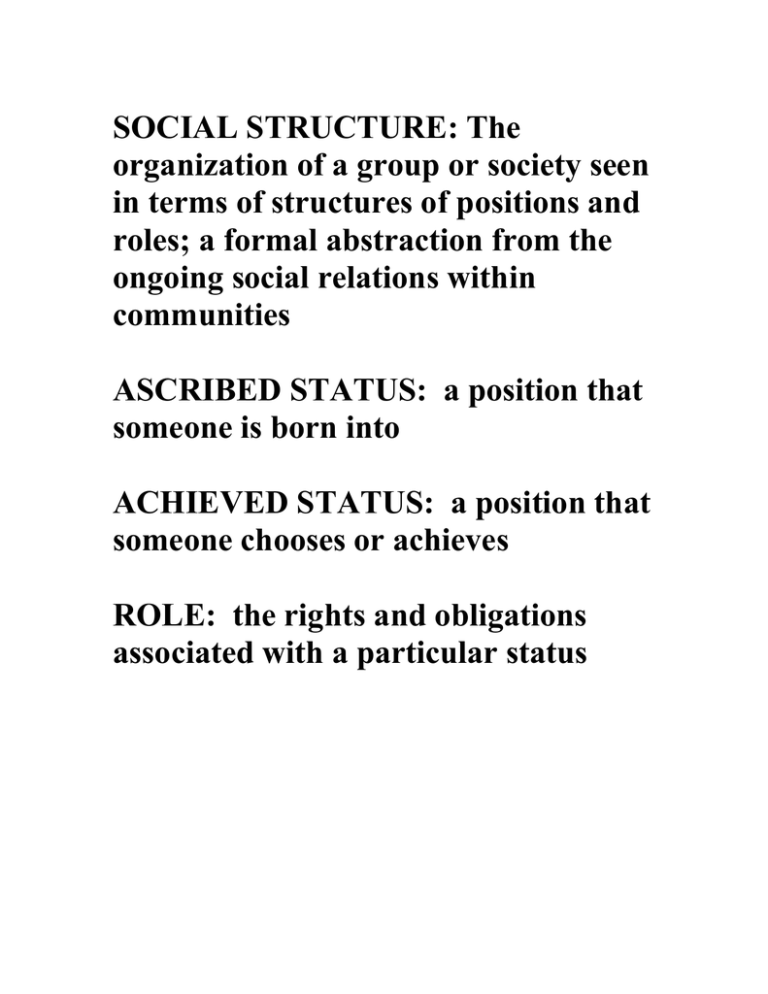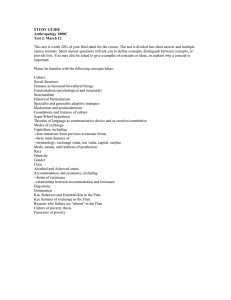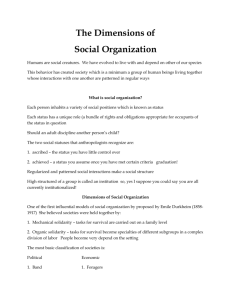SOCIAL STRUCTURE: The organization of a group or society seen
advertisement

SOCIAL STRUCTURE: The organization of a group or society seen in terms of structures of positions and roles; a formal abstraction from the ongoing social relations within communities ASCRIBED STATUS: a position that someone is born into ACHIEVED STATUS: a position that someone chooses or achieves ROLE: the rights and obligations associated with a particular status EGALITARIAN SOCIETIES: societies in which no great differences in wealth, power, or prestige divide members from one another. STRATIFIED SOCIETIES: societies in which there is a permanent hierarchy that accords some members privileged access to wealth, power, and prestige. Mechanical Solidarity: characteristic of kinship based societies; all members basically alike (all hunter, farmers, etc., with common ancestors), largely self-sufficient, and see themselves in each other. Organic Solidarity: societies characterized by mutually interdependent subgroups, each of which specializes in a different task necessary for survival. Class: a ranked group within a hierarchically stratified society with particular access to valued resources and whose membership is defined primarily in terms of wealth, occupation, or other economic criteria. Caste: a ranked group within a hierarchically stratified society that is closed, prohibiting individuals to move from one caste to another. Race: a group whose boundaries allegedly correspond to distinct sets of biological attributes Racialism: belief in the existence of biologically distinct races. Racism: the systematic oppression of one or more socially defined “races” by another socially defined “race,” justified in terms of supposedly inherent biological superiority/inferiority. Ethnicity: classification of groups in terms of selected cultural features, e.g., language, religion, customs, history. Gender: The cultural construction of beliefs and behaviors considered appropriate for each sex. Sex/Gender System: Set of arrangements by which the biological raw material of human sex and procreation is shaped by human, social intervention and satisfied in a conventional manner. Features of exchange in the Flats 1st, exchange is not immediate. People don’t give each other things at the same time. 2nd, exchange creates relationships and relationships create exchange. 3rd, as in many non-western societies, exchange in the Flats is embedded in a kinship system 4th, exchange “pervades the whole social-economic life of participants” (39) 5th, exchange involves a high degree of calculation and planning PERSONAL KINDREDS Relatives: genealogical links in a cognatic/bilateral descent system Kin: relatives or others who have “kinship” links entailing particular sets of rights and obligations Essential kin: kin who “activate and validate their jural rights by helping one another, thereby creating reciprocal obligations toward one another.” Why fathers/husbands are “absent” in the Flats 1st, the precariousness of paid work 2nd, women’s control over AFDC resources. which travel through women 3rd, the security of women’s kin network COOPERATIVE UNITS mutual aid among siblings of both sexes domestic cooperation of close adult females FUNCTIONS OF POVERTY low-wage labor jobs for welfare workers; policy makers; police a source for the consumption of cheap goods construction of an elite provide a indicator/measuring stick for the rest of us provides stereotypes of the “Other” that help us define ourselves philanthropy and charity value what we have






